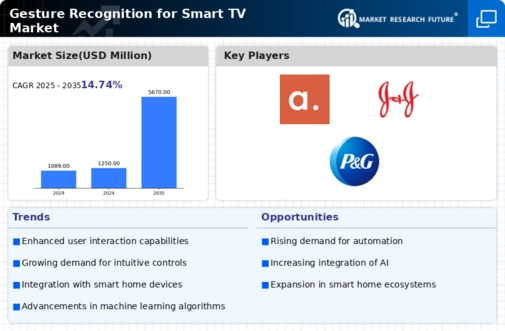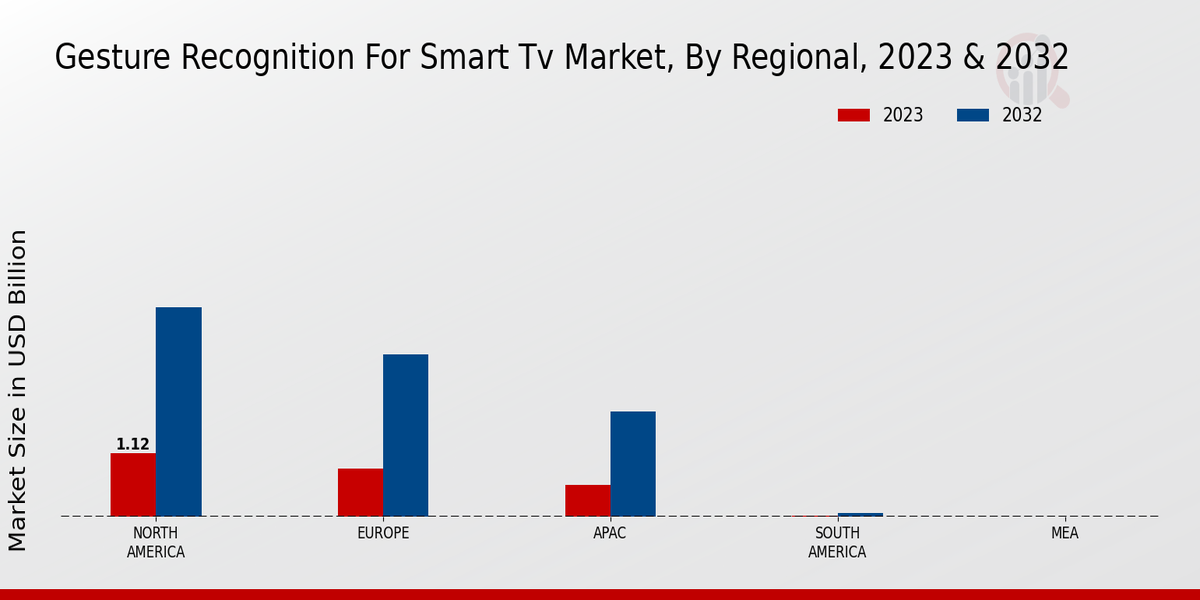Market Growth Projections
The Global Gesture Recognition for Smart TV Market Industry is projected to experience substantial growth over the next decade. With a market value expected to reach 1250 USD Million in 2024 and an impressive forecast of 5670 USD Million by 2035, the industry is on a robust upward trajectory. This growth is underpinned by a compound annual growth rate (CAGR) of 14.74% from 2025 to 2035, indicating a strong demand for gesture recognition technologies. As manufacturers continue to innovate and enhance user experiences, the market is likely to attract significant investment and attention, positioning gesture recognition as a key component of the future of smart entertainment.
Increased Focus on User Experience
An increased focus on user experience is driving growth in the Global Gesture Recognition for Smart TV Market Industry. Manufacturers recognize that enhancing user interaction through gesture recognition can differentiate their products in a competitive landscape. By providing intuitive navigation and control options, companies aim to improve customer satisfaction and loyalty. This emphasis on user-centric design is evident in the development of smart TVs that incorporate gesture recognition as a standard feature. As a result, the market is poised for growth, with the potential for significant revenue generation as consumers prioritize user-friendly technology in their entertainment choices.
Growing Adoption of Smart Home Ecosystems
The Global Gesture Recognition for Smart TV Market Industry is significantly influenced by the growing adoption of smart home ecosystems. As consumers increasingly integrate smart devices into their homes, the demand for seamless interaction between these devices rises. Gesture recognition technology facilitates this interaction, allowing users to control their smart TVs effortlessly alongside other connected devices. This interconnectedness enhances user convenience and promotes the adoption of gesture-enabled smart TVs. The market is expected to expand substantially, with projections indicating a rise to 5670 USD Million by 2035, reflecting the increasing integration of gesture recognition within broader smart home solutions.
Rising Demand for Interactive Entertainment
The Global Gesture Recognition for Smart TV Market Industry experiences a surge in demand for interactive entertainment solutions. As consumers increasingly seek immersive viewing experiences, gesture recognition technology offers a hands-free interface that enhances user engagement. This trend is particularly evident in the growing popularity of smart TVs equipped with gesture control features, allowing users to navigate content seamlessly. The market is projected to reach 1250 USD Million in 2024, reflecting a robust interest in innovative entertainment technologies. This demand is likely driven by advancements in artificial intelligence and machine learning, which improve gesture recognition accuracy and responsiveness.
Expansion of Content and Application Ecosystem
The expansion of the content and application ecosystem significantly impacts the Global Gesture Recognition for Smart TV Market Industry. As streaming services and applications proliferate, the need for efficient navigation and interaction becomes paramount. Gesture recognition technology enables users to explore vast libraries of content effortlessly, enhancing the overall viewing experience. This trend is likely to encourage manufacturers to integrate gesture recognition features into their smart TVs, catering to the evolving preferences of consumers. The anticipated growth in this sector aligns with the broader trend of increasing content availability, further driving the adoption of gesture-enabled smart TVs.
Technological Advancements in Gesture Recognition
Technological advancements play a pivotal role in shaping the Global Gesture Recognition for Smart TV Market Industry. Innovations in computer vision and sensor technologies have led to more sophisticated gesture recognition systems, enabling precise tracking of user movements. For instance, the integration of depth-sensing cameras and infrared sensors enhances the ability to interpret complex gestures. As these technologies evolve, they contribute to a more intuitive user experience, fostering greater adoption of smart TVs with gesture control capabilities. The anticipated growth trajectory, with a projected CAGR of 14.74% from 2025 to 2035, underscores the importance of continuous innovation in this sector.













